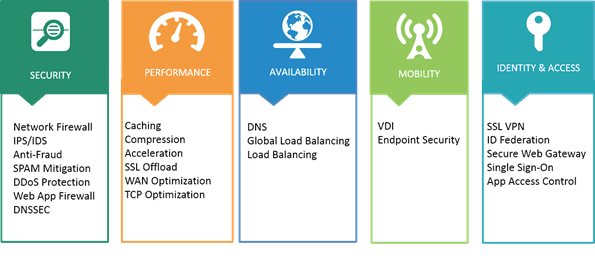When I say “app services” or, to use the more common networking-oriented moniker, “L4-7 services”, what do you think of?
Wait, let me guess. You thought of:
- load balancing
- caching
- WAN optimization
Am I (at least mostly) right?
Those are the three most commonly referenced “app services” in just about any article focused on SDN or SDDC or SD-something-or-other today.
And yet these services barely scratch the surface of what a comprehensive list would look like.
When we put together the first State of Application Delivery survey to explore trends and the use of app services across the globe, we asked about over 20 different app services. 24, to be exact, which you can be sure I will at some point enumerate for you. Now I don’t think it’s necessary for those writing on the topic of app services to include all 24 (or more) services as examples of what is meant by “L4-7 services.” But I do think the continued use of the aforementioned list of commonly referenced app services is problematic in that it doesn’t provide insight into the breadth and depth of services available for applications in the network today.

If you’ve read the report or read anything on our architectural vision, Synthesis, then you know that we generally categorize app services in five separate buckets: availability, security, performance, identity and access, and mobility. Each of those categories has a varying number of services within it. For example, availability comprises DNS, GSLB, and LB (load balancing). Mobility has just two services (right now): VDI and Endpoint Security. Performance? It includes the often mentioned caching and WAN optimization, but also includes compression and TCP optimizations (like multiplexing) as well. And security… well, security is probably the largest category, comprising seven different services.
In all, there are at least 24 different “app services” that may be (and often are) deployed in the network between the client and its ultimate destination, the app.
And if you ask people about their use of these services (which we did cause that was the point of our survey) you’ll find that the use of these services is pretty pervasive. In fact, 30% of respondents have deployed (right now, today) all 24 of those services. Now that’s not saying that every app traverses every one of those two-dozen services. It’s saying that all those services are deployed and in use, which means some apps are using some of them, while other apps are using others of them. We could argue that nearly all are taking advantage of DNS and network firewalling and most are probably using load balancing, but after that it gets harder to definitively assert which apps are using which services. But some app, somewhere, is using that service. Today. Right now.
That’s important for IT leaders and practitioners because they are often tasked with solving problems or addressing challenges and it just might be that they aren’t aware that the org already has in place a service that can do what they need it to do because it wasn’t used or needed for other apps they’ve deployed in the past. It’s really important for leaders of silos because knowing might mean folks in app dev don’t actually have to reinvent wheels (saving time) nor would ops need to procure, deploy, and maintain a diverse set of unsupported platforms (saving opex and reducing downtime) to supply an existing service.
They just have to know they exist in the first place.
As Saturday morning cartoons (and a million memes on the Internet) taught us, knowing is half the battle*.
This is where cataloging comes in handy. Having an inventory of services already in the data center with which you have experience is invaluable because an existing service means you likely have the skills to deploy and manage those services, thus drastically reducing the time to deploy and configure said services for the applications that need them.
So remember, there are (a lot) more than just three app services out there and the numbers say there’s likely more than that (actually the average organization deploys 11 app services) actively delivering and securing apps right now in your very own data center. Get familiar with them, catalog them, and make use of them.
They are the software that’s delivering the software that runs today’s business.
*The other half is red and blue lasers and for that, you’re on your own.
About the Author

Related Blog Posts

AppViewX + F5: Automating and orchestrating app delivery
As an F5 ADSP Select partner, AppViewX works with F5 to deliver a centralized orchestration solution to manage app services across distributed environments.

Build a quantum-safe backbone for AI with F5 and NetApp
By deploying F5 and NetApp solutions, enterprises can meet the demands of AI workloads, while preparing for a quantum future.

F5 ADSP Partner Program streamlines adoption of F5 platform
The new F5 ADSP Partner Program creates a dynamic ecosystem that drives growth and success for our partners and customers.
F5 NGINX Gateway Fabric is a certified solution for Red Hat OpenShift
F5 collaborates with Red Hat to deliver a solution that combines the high-performance app delivery of F5 NGINX with Red Hat OpenShift’s enterprise Kubernetes capabilities.
F5 Silverline Mitigates Record-Breaking DDoS Attacks
Malicious attacks are increasing in scale and complexity, threatening to overwhelm and breach the internal resources of businesses globally. Often, these attacks combine high-volume traffic with stealthy, low-and-slow, application-targeted attack techniques, powered by either automated botnets or human-driven tools.
Phishing Attacks Soar 220% During COVID-19 Peak as Cybercriminal Opportunism Intensifies
David Warburton, author of the F5 Labs 2020 Phishing and Fraud Report, describes how fraudsters are adapting to the pandemic and maps out the trends ahead in this video, with summary comments.
